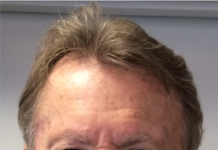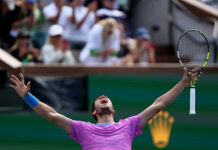Bill Simons
Paris
It’s said, “Only mad dogs and Englishmen go out in the midday sun.” Well, these days only rabid fans and crazed journalists dare cross Roland Garros during France’s fabled lunch hour. At the center of the grounds there’s pure gridlock. Grit, determination and a tolerance for pain are needed to navigate the throngs.
But these days watching “Big Foe” (that would be Frances Tiafoe) is good reason to venture forth. After all, it’s a challenging time for American men’s tennis. The injured John Isner and Sam Querrey have both withdrawn from the tourney. Jack Sock, who is also mending, is No. 165. Stevie Johnson has fallen to No. 65. Riley Opelka and Fritz Taylor are trending up nicely, but… Here in Paris, where no American man has won so far, our lonely eyes turned to Big Foe. He was almost a Davis Cup hero. He reached the Australian quarters, he had good runs in Miami, Portugal and Madrid, and was the top-seeded American at the French.
Plus, this guy has a glint in his eye. He lights up locker rooms. The son of survivors of a bloody civil war in Sierra Leone, he has one of the greatest family backstories in tennis history – and he’s the most charismatic American newcomer since Andy Roddick.
GQ Magazine noticed. They just called him the “next great American hope,” dressed him up in orange pants and a green and white blazer and offered a fashion spread to die for. They said Frances, who is ranked No. 35, is “the sport’s greatest showman, our country’s latest and maybe best, most realistic hope: a player with the tools, the swagger, and the competitive drive to contend with anyone.”
No wonder today the picturesque Court 12 – across from a grand boulevard, a canopy of trees and a stately mansion – was packed. Still, some were unimpressed. During his first-round match against the savvy 27-year-old Serbian, Filip Krajinovic, an Italian chatted on his phone and a woman read a book on her kindle. But most were passionate. A Parisian fan wearing a French Foreign Legion hat led the crowd in pro-Tiafoe chants: “Frahn-sez, Frahn-sez!” the crowd yelled. Tiafoe had to be smiling. He’d told GQ, “Tennis needs more personality…and a younger crowd to follow the game and to make tennis look cool again.”
Among other things, what’s cool about Frances, who is a product of Maryland’s Junior Tennis Champions Center, is his forehand. Writer Zach Baron explained: “As the ball comes his way, his right arm begins to describe strange pathways behind his body, like a dragon wing unfurling — and more wrist in the shot than any instructor would typically teach. But the technique…allows him to generate incredible amounts of torque as his body turns…The effect is of a slingshot being pulled way back, and then fired. Balls come off his forehand side incredibly heavy, dizzy with spin. They seem to be going up, not down…as if dropped from a cliff.”
But in Paris, Tiafoe invariably drops away. As a pro he’s failed over the past four years to win one singles match at Roland Garros. Of course he’s far from being a “cow on ice,” (as Maria Sharapova jokingly once described herself on clay). Tiafoe is fast – a sublime athlete and a shotmaking whiz. But too often today, his forehand flew long. He offered bailout drop shots that seemed like moonballs. Still, he twice bravely fought back from being a set behind and forced a decisive fifth set. Few noticed a not-so-minor detail: on court after the second set he vomited
In the end he was spent. His body drooped. He smashed a racket, looked to the sky, and held out his arms as if to ask, “What can I do?” For Tiafoe, intent and will are everything. At Wimbledon, at the Davis Cup and here, Big Foe has had big issues closing out big matches. Still, he told GQ, “If you want to be successful as bad as you want to breathe, then you’ll be successful.” In Australia, microphones picked up a simple x-rated question he put to himself: “How bad do you f–king want it?”
Today, Frances had no answers. In just under three hours he fell 6-2, 4-6, 6-3, 3-6, 6-0. “You work so hard,” he said, “You want to do your best and you have this random illness [and] you have no idea why it’s occurring. It’s tough to lose like that…Throwing up during the match isn’t something that normally happens to me…I threw up again when I went to the locker room after the third set. [In] the fifth set…I had nothing really in me. It was tough to end like that.”
But Frances is hardly through. Yes, he needs to work on his focus and his ability to close matches. Still, his savvy foe, Krajinovic, said Tiafoe could reach the top ten or fifteen.
Clearly, Big Foe has a big future and big ideas. He told GQ, “I want young kids to play tennis because of me. I want to really change people’s lives with what I do for a living.”
BUCKNER AND NOVOTNA – FOR THE ENTIRE HUMAN RACE: Today’s news of the death of former Boston Red Sox first baseman Bill Buckner, who infamously let a key grounder go through his legs against the New York Mets in the 1986 World Series, brings to mind one of the most poignant comments in tennis history. After Jana Novotna collapsed terribly against Steffi Graf at Wimbledon in 1993, Simon Barnes noted, “Novotna played a game of tennis for everyone who has ever made an absolutely ghastly mistake, or to put it another way, for the entire human race.”



















